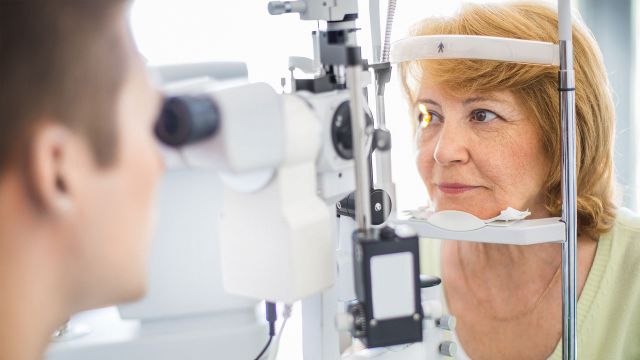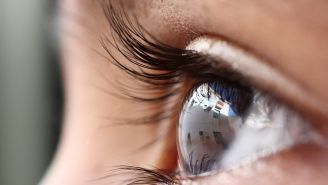Updated on September 30, 2022.
Nearly 166.5 million American adults use prescription glasses to correct their vision, per a report from the Vision Council in 2021. But getting glasses or contacts is just one reason to see a vision specialist. Comprehensive eye exams are essential for the early detection of health issues that can affect your vision.
As you age, your risk for diseases that can affect your sight—like glaucoma, cataract, and age-related macular degeneration (AMD)—increases. Nearly 3 million Americans have glaucoma, most of them over the age of 40. At least 24.4 million Americans aged 40 and older have cataract in one or both eyes, and roughly 1.8 million Americans aged 40 and older are affected by AMD, according to data from the Centers for Disease Control and Prevention (CDC).
“Even though someone seems okay, sometimes there can be eye diseases that are manifesting before the patient really has time to see them,” explains Corrie Weitzel, OD, MS, an optometrist at Cleveland Clinic’s Cole Eye Institute. “Routine eye exams are going to find those kinds of conditions and treat them before vision loss can set in.”
Americans aren’t getting their eyes checked
Despite the utility of eye exams, data suggests they’re underutilized. A survey conducted in 2021 by NVision Eye Centers of 1,209 Americans showed that 1 in 10 have not had an eye exam in the last 5 years or more. And of the nearly 93 million adults in the U.S. who are at high risk for serious vision loss, only half visited an eye specialist in the previous 12 months, according to the CDC.
While visiting an eye specialist can feel like a hassle—and yet another medical expense—it’s worth noting that there are free or low-cost options available, particularly for older people and those at higher risk for eye diseases.
What happens during an eye exam
The practitioners you may see for a comprehensive eye exam include medical doctors called ophthalmologists or licensed healthcare professionals known as optometrists. During an exam, healthcare providers specializing in the eyes and vision can not only pick up eye diseases that could lead to blindness or other complications but can also detect certain other underlying health issues that may affect your eyes.
A comprehensive eye exam will likely include:
- Dilation: You will receive eye drops that widen your pupil, allowing more light to enter your eye. (This is why you will be sensitive to light for a few hours after your appointment.) Once your pupils have been widened, your eye care provider will have a better view of what’s going on in the back of your eye.
- Tonometry: This test is used to measure the pressure inside your eye. It can detect glaucoma.
- Vision tests: These tests will assess your visual acuity (sharpness), peripheral (side) vision, and depth perception as well as your eye alignment and movement.
Why regular eye exams are essential
Some eye problems don’t cause symptoms while others may develop gradually. In fact, their progression may be so slow that you may not even notice the problem until it has become severe. Regular eye exams are your best bet for finding eye diseases and eye-related issues before they threaten your vision or your health.
One of the most common reasons most of us end up getting a comprehensive eye exam (as a child or as an adult) is because we’re having trouble seeing things far away (myopia, or nearsightedness) or close up (hyperopia, or farsightedness).
As people get older, they could also develop presbyopia, or age-related loss of the ability to focus at close range. Astigmatism, which is an irregularity in the curvature of the cornea or lens, could also affect the sharpness of your vision. If you wear contacts or eyeglasses, your eye care provider will likely recommend that you come in regularly to have your prescription checked, Weitzel says.
Some of the other less common—but potentially serious—eye problems your provider might diagnose during a routine comprehensive exam include:
Amblyopia: Also called “lazy eye,” amblyopia is one of the most common eye-related problems among children. It can develop when there is a problem with the brain-eye connection (strabismus), causing one eye to be weaker than the other so they do not work together properly. If detected early on, these issues can be addressed and treated, reducing the risk for changes in vision.
Uveal melanoma (UM): Eye melanomas, which are relatively rare, can develop in the cells in your eye that produce pigment. Many people with UM don’t have symptoms at the time they’re diagnosed, which makes routine eye exams especially important.
Choroidal nevi (choroidal freckles): These are relatively common noncancerous lesions that develop in the back of the eye. They don’t usually require treatment unless they become cancerous or there is an increased risk for melanoma.
Age-related macular degeneration (AMD): As the name implies, this problem is typically linked to aging and occurs when either abnormal blood vessels grow behind the retina and cause blood and fluid to leak (also known as wet AMD), or when the macula (the most sensitive part of the retina) thins over time (a condition called dry AMD). AMD is a leading cause of permanent vision loss in older adults.
Open-angle glaucoma: This is the most common form of glaucoma, accounting for at least 80 percent of all cases. It results from gradual clogging of the eye’s drainage canals, which increases pressure inside the eye. In cases of open-angle glaucoma, the angle where the iris meets the cornea is as wide as it should be. There may not be any noticeable vision loss until the disease has progressed to an advanced state, which makes routine eye exams critical for early detection.
Cataract: If not treated, this clouding of the eye lens can lead to blindness. Cataracts can develop at any age or be present at birth, but they are more common in older adults. Cataracts are treated with a routine surgical procedure.
Other health conditions that may be detected
Certain underlying health issues can affect your eyes and your vision. Even before you develop symptoms, an eye provider can detect subtle change in your eyes, such as swelling of the optic nerve, bleeding, or floating white blood cells within the eye. An eye exam can help your provider diagnose these conditions early on before they’ve progressed. This can not only help you get the treatment you need but also protect your vision.
“There are many times where people come in for a routine eye exam and we look inside and see signs of a systemic disease, which would make them want to follow up with their primary care doctors,” Weitzel says.
Some of the underlying health issues that could be detected during a comprehensive eye exam include the following:
- Diabetes: Over time, high blood sugar levels can damage the blood vessels in the retina. This condition, called diabetic retinopathy, is a leading cause of blindness among U.S. adults.
- Anemia: If you are iron deficient, the skin inside your eyelids may look pale.
- High blood pressure: This condition can damage the vessels supplying blood to the retina. It can lead to bleeding in the eye, blurry vision, or fluid buildup under the retina.
- Multiple sclerosis (MS): This disease can lead to inflammation of the optic nerve or damage to the nerves involved in eye movements. This can lead to double or blurred vision and painful eye movements.
- Rheumatoid arthritis (RA): This chronic inflammatory disease could lead to dry eyes. RA can also cause inflammation in the white part of the eyes, causing redness and pain.
- Lupus: This autoimmune disease can affect the eyes, leading to changes in the skin around the eyelids, dry eyes, inflammation of the white part of the eyes, blood vessel changes in the retina, and damage to the nerves involved in eye movement.
- IBD (inflammatory bowel disease): Roughly 10 percent of those with IBD experience eye problems. In most cases, these issues—which can lead to symptoms like irritation, sensitivity to light, or redness—are treatable.
When to have your eyes examined
How often you need an eye exam depends on certain factors, including your age and other risk factors for eye-related health issues. Be sure to talk to your eye provider or your primary care provider about what is right for your situation.
There is no doubt that regular comprehensive eye exams are important, Weitzel says, but how “regular” they should be is a complicated answer.
The American Academy of Ophthalmology recommends that adults younger than 40 years old with no signs of risk factors for eye disease get a comprehensive exam every 5 to 10 years. Those between 40 and 54 years old should have an exam every 2 to 4 years, and people 55 to 64 years old should have one every 1 to 3 years. By the age of 65, adults should get a comprehensive eye exam once per year or every other year.
Those at higher risk for glaucoma and other eye diseases—such as African American, Asian American, or Latinx people—may need more frequent screenings, such as every year. Likewise, people with risk factors for conditions that can affect the eyes, such as high blood pressure or diabetes, may also need to be examined more often.
For example, people with type 1 diabetes should be examined by an ophthalmologist within five years of diagnosis and then every year thereafter. Those with type 2 diabetes should have their eyes examined at least once per year after being diagnosed. Check with your healthcare provider on the schedule that makes the most sense for you.
Eye symptoms you shouldn’t ignore
If you develop any sudden change in your vision, don’t wait until your next scheduled eye exam. Seek medical attention right away. The following symptoms could signal a serious health issue:
- Blurry vision, double vision, or vision loss
- Eye pain, burning, or stinging
- Painful red, swollen, or itchy eyes
- New or more floaters (tiny black dots or specks that appear to float before your eyes)
- Circles (halos) around lights
- Flashes of light
- Unusual sensitivity to light
- Difficulty adjusting to dark rooms (night blindness)
- Unequal pupils (one pupil is larger than the other)
- Bruising around the eye







